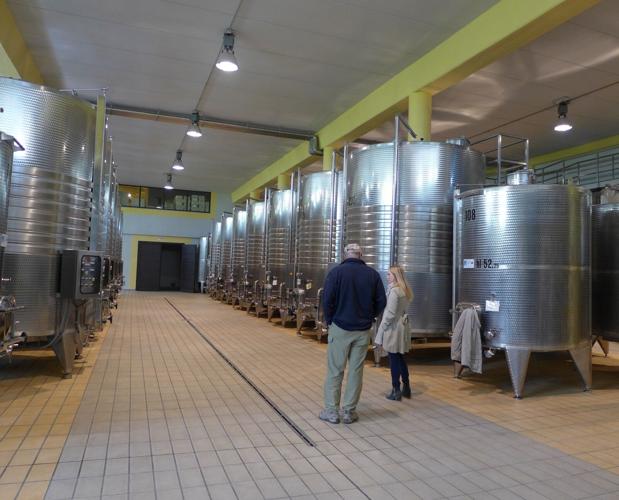There are times in life when things just seem to come together. Forrest Gump’s mother used to say, “like peas and carrots.” It is providential that part-two of my wine pricing series: ‘activities in the wineries that influence pricing,’ comes right around April Fools’ Day. Be forewarned, this article may leave you a bit disillusioned about that wonderful $10 red blend which has become your go-to wine.
Winemaking is part art and part science, and when you look at the major label brands that populate the shelves of every wine shop and grocery store in the country it is mostly science. These behemoth brands produce wines by the tens of thousands of gallons. They focus primarily on two factors: turning out wines within a particular price point and developing a consistent style and flavors of wine that appeals to a broad demographic of consumers. When making wines in such huge quantity, the only method to ensure both cost control and consistency is through the application of industrial chemistry. The production of these wines is based on a formula that is tweaked from year to year depending on the quality of the base product: the grapes.
In a perfect world, most wine would be produced from grape must, native yeasts and possibly flavor compounds extracted from wooden barrel aging, though this is not feasible in today’s high-volume world. Most wines need the inclusion of non-native yeasts to complete a successful fermentation and a stabilizer (usually sulfur dioxide) to prevent spoilage, but that is only the starting point. Mass market wines, both inexpensive and high end usually require a certain amount of doctoring. Fundamental elements such as the alcohol level, sugar, acidity & PH levels, tannins, colors and flavor compounds are open to ‘adjustment.’
Even the actual varieties of grapes used can be tailored for economic and stylistic reasons. A number of extremely popular Pinot Noir and Cabernet Sauvignon brands contain significant levels of other varieties; first, because these grapes are less expensive and secondarily, they add the richness and flavor that most consumers prefer and allow for the use of a lower grade base grape. The use of full bodied, rich, fruit forward grapes, often either Petite Sirah or Zinfandel, covertly ‘pump up’ the varietal-labeled wines and mislead consumers who believe that their drinking 100 percent Pinot Noir or Cabernet. In most of the US, the addition of other grape varietals does not have to be listed on the bottle’s label as long as the quantity is less that twenty five percent.
Many European wineries are bound to strict regulations in order to have their wines labeled as appellation approved. In other parts of the world the requirements are more lenient; allowing for more experimentation as well as the use of various manipulation and additives. The goal for many wine producers is to deliver what is known as an ‘international style’ wine: plush, with fruit forward flavors, slightly sweet, not too tannic or acidic, with limited earthy or vegetal notes. These easy drinking wines, called ‘crowd pleasers,’ often lack complexity or sense of place, but can be bought on the cheap.
Winemakers can make use of sub-par grapes in their wines and enhance the appearance and flavor through abroad variety of additives. Rich, deep color tones are often achieved by the inclusion of food coloring concentrates such as Mega Purple and Ultra Red. There are numerous other additives available for winemakers to tweak their product: Gum Arabic is used to soften harsh, unripe tannins; powdered tannin can be added to enhance structure; tartaric acid provides mouth tingling acidity; dimethyl dicarbonate addresses unwanted bacteria and fungus in wines produced from damaged grapes or unsanitary production practices; gelatin and Trypsin are used as clarifying agents and that vanillin flavor that comes from barrel aging can be (imperfectly) recreated with oak chips and liquid oak essence. Other than sulfides, the FDA does not require wineries to list the ingredients on the label, so most of these shenanigans remain hidden from the consumer.
These additives are just a few of the many techniques winemakers have at their disposal. A broad variety of equipment exists to filter, spin, infuse and micro-oxygenate wines. The use of this technology is a perfectly acceptable practice ensuring high quality and consistency, while reducing the element of chance that occurs in low intervention winemaking. For budget brand producers, the upsides are the ability to make the most of less expensive or inferior grapes; being able to rush the juice through the production process and eschewing the use of expensive oak barrels, all of which reduces the end cost (hence the $10 red blend). The downside is that over manipulation can produce shockingly bad wine.
The more that the winery invests in quality grapes; high end production equipment; oak barrels, as well as hiring growers and winemakers who have the expertise and patience to bring out the best from a particular grape harvest without resorting to convoluted chemical engineering, the more the wine will cost and of even greater importance, the better the wine will be.
Next month I will shine the spotlight on the distribution side of the wine business. Until then, drink well and drink carefully!
Salute.’
Tom Oetinger holds an advanced certification in wine & spirits from the WSET in London, England. He is available to assist you with your wine events or answer your wine questions. Tom also offers a free email service, recommending high quality, good value wines available locally. Contact / subscribe at tjo1913@gmail.com.




